- Wondering how to get Monopoly GO! free rolls? Well, you’ve come to the right place. In this guide, we provide you with a bunch of tips and tricks to get some free rolls for the hit new mobile game. We’ll …
Best Roblox Horror Games to Play Right Now – Updated Weekly
By Adele Wilson
Our Best Roblox Horror Games guide features the scariest and most creative experiences to play right now on the platform!The BEST Roblox Games of The Week – Games You Need To Play!
By Sho Roberts
Our feature shares our pick for the Best Roblox Games of the week! With our feature, we guarantee you'll find something new to play!Anime Fantasy Codes – Free Gems and Tokens
By Adele Wilson
Our Anime Fantasy Codes guide has a list of codes that offer up a variety of rewards, such as gems, tokens, and lots more!
Harvest Moon: Seeds of Memories Review – Reaps What It Sows
Harvest Moon will turn 20 this year, and despite the long-running series’ predilection for portable gaming (16 of the main entries’ 24 titles are on handheld systems), we’ve never had a mobile version until now. 2009’s Frantic Farming was a …
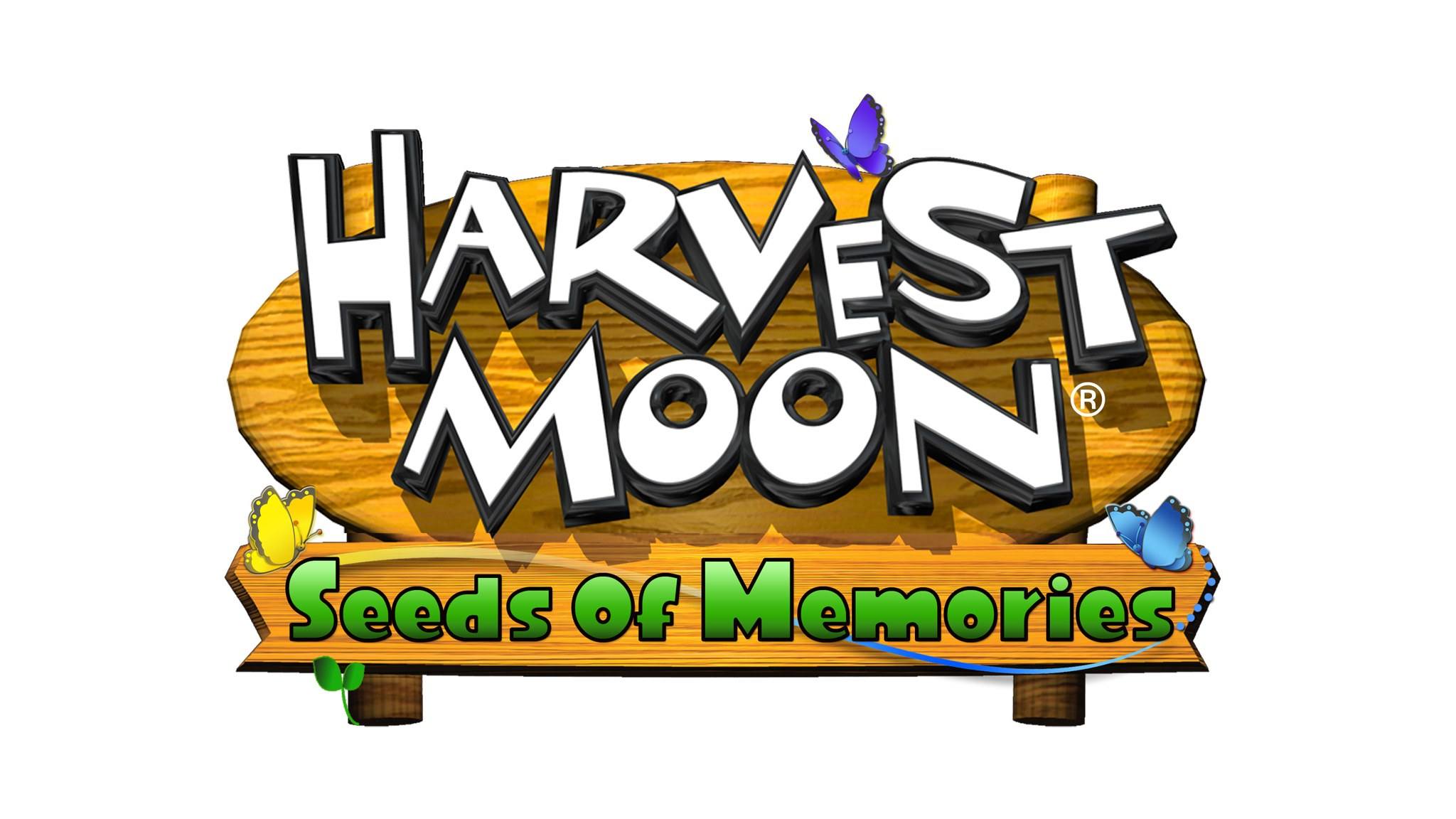
Harvest Moon will turn 20 this year, and despite the long-running series’ predilection for portable gaming (16 of the main entries’ 24 titles are on handheld systems), we’ve never had a mobile version until now. 2009’s Frantic Farming was a simple puzzle spin-off with little relation to the series’ core roots. Thankfully, the same cannot be said of Seeds of Memories: this is a true Harvest Moon game with all of the farming sim’s familiar trappings, from daily crop-watering to the years-long pursuit of a spouse and two kids.
For a series as prolific as Harvest Moon, it’s difficult to offer a review without at least briefly touching on the game’s history. The first title, released on the SNES in 1997, was developed by Victor Interactive (later bought by Marvelous) and published in North America by Natsume. For decades, Marvelous and Natsume were partners in bringing near-yearly releases to fans. In 2014, the two went their separate ways: Natsume retained the rights to the name “Harvest Moon” while Marvelous kept the developers that actually created the two-dozen games that still bear the HM moniker. Both companies decided to keep developing farming sims, and the result was basically two Harvest Moon games released for the 3DS in 2015: Harvest Moon: The Lost Valley, by Natsume, and Story of Seasons, by Marvelous.

Between the two of them, Marvelous is the team with experience actually creating a Harvest Moon game. Story of Seasons was the natural evolution of the last HM game, A New Beginning, and feels like the expected next step in the series. The Lost Valley, however, was a strange combination of Minecraft-esque terraforming and a greatly diminished world: instead of farming alongside a village packed with townspeople to meet and woo, you were essentially trapped on your plot of land and forced to wait for random passerby to visit you. Many of the features fans had come to know and love in Harvest Moon—from the open world to sensible seasons—were removed or reduced, resulting in a critical disappointment.
This split and ensuing misstep is worth noting as Seeds of Memories is only Natsume’s second attempt at developing a Harvest Moon game. Although the series has evolved over the years and tried different things—including the robot-powered Innocent Life and the superb action RPG-hybrid Rune Factory—the core entries have maintained certain tenets that keep fans coming back: farming, relationships, and freedom. Natsume stumbled over some of these while developing The Lost Valley, but they’ve thankfully made these elements central once again in Seeds of Memories.
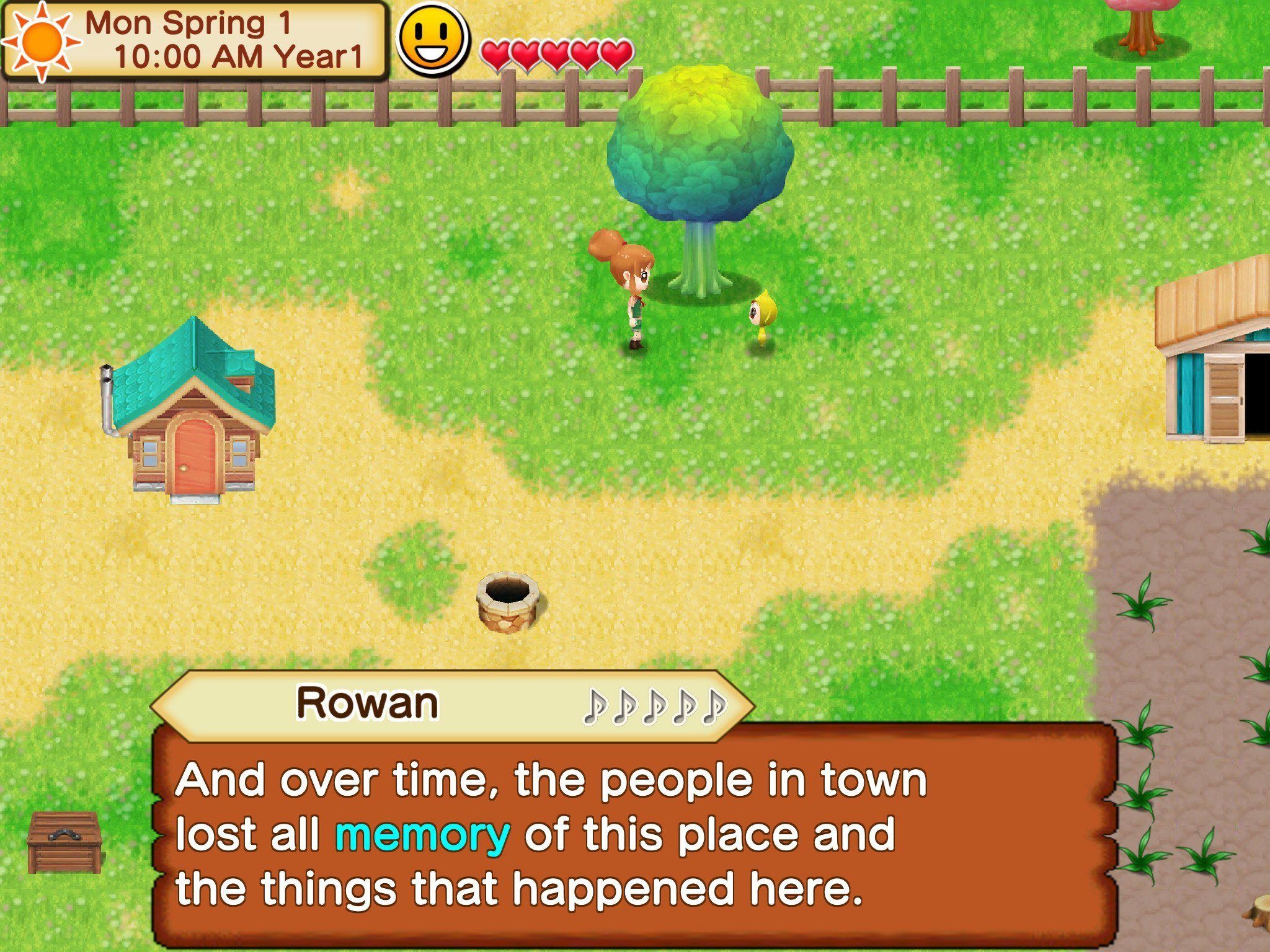
There’s a lot to praise in this freshman mobile entry, but let’s clear away the debris first. To begin with, Seeds of Memories has the worst story of any Harvest Moon to date, which is a pretty impressive feat considering a large number of the series’ entries just run with “You’ve inherited a farm; good luck!” While wandering in the mountains, you randomly come across an abandoned farm and depressed harvest sprite: the sprite tells you his home, the Sprite Tree, is nearly dead because the nearby townspeople forgot this farm existed. He says if only someone would revive it and remind the villagers of its existence, the land will be saved. Instead of just inviting the townspeople to walk the five feet east to see the farm for themselves, you’re tasked with creating over a hundred new memories with the townspeople, which will somehow open up past memories of the farm. This is even more ridiculous than it sounds, as a lot of your early conversations with villagers involves them wondering “Was there a farm over there?” and claiming, “No, I’m pretty sure there’s nothing to the east,” despite the fact that they can probably see your fields from their windows and you’re constantly handing them fresh-from-the-dirt crops likely stamped with “Farm East of Town” logos.
While the barely-there story is surprisingly weak, it doesn’t impact your day-to-day life that much. What will come up repeatedly is Seeds of Memories’ sorely lacking aesthetics. The game is, simply, not attractive. While I try not to put too much emphasis on graphics, the visuals here are not only unappealing, but lazy. Most of the backgrounds look like default RPG Maker tiles, and there is very little variety throughout the world. This is especially disappointing as there are only three maps in the game: your farm, the town, and the mountain. And yet there wasn’t room or incentive to add details to the extremely bland areas. For example, the pieces of fruit you can pick up on the mountain—apples, oranges, peaches, etc.—are all represented by the same purple fruit icon. You won’t know what you’re getting until you actually pick it up. Similarly, every house in town is laid out the same: bed, dining area, small kitchen. No one has any decorations or unique furniture; everyone even has the exact same two coffee cups sitting out on their table. As a comparison, here’s Witchie’s house in Story of Seasons. It’s got crazy wallpaper, a lovely pink tea table, and stuffed frogs all over the place. You won’t see anything even close to this in Seeds of Memories.

This lack of effort extends to the villagers’ daily routines, as well. In basically every Harvest Moon since the dawn of HM time, villagers would at least attempt to look like they had lives and interests outside of desperately waiting for you to come talk to them. Even way back in the SNES entry, Ann hammered away in her shop, Maria swept the church steps, and Nina pranced around outside the flower shop. In Seeds of Memories, NPCs stand perfectly still in their assigned spot. They will sometimes stand perfectly still in a different spot, depending on the day and time. They won’t interact with each other, save occasionally sharing a table at the restaurant (Rune Factory fans who got used to stumbling upon villager slumber parties: lower your expectations). Their complete lack of lives outside of their relationship with you makes it easy to find anyone in spite of the absence of a mini-map, but it leaves a giant hole in the game’s heart and charm.
Despite all of these disappointments, Seeds of Memories is still fun to play. What it lacks in beauty and attention to detail it makes up in gameplay and classic Harvest Moon freedom. Natsume has abandoned many of the modern additions that have made up recent entries—no more town-building or clothes designing—to focus on those core tenets we mentioned above. After a very short tutorial on the first day, your life is your own. You can till a giant field for crops or go fishing in the mountains. You can go to town to buy recipes for cooking or spend hours chopping wood before recovering in the hot spring. You can, and likely will, spend large portions of your days collecting ore in the multi-level mine, a feature that has been sorely missed in the series for many years.
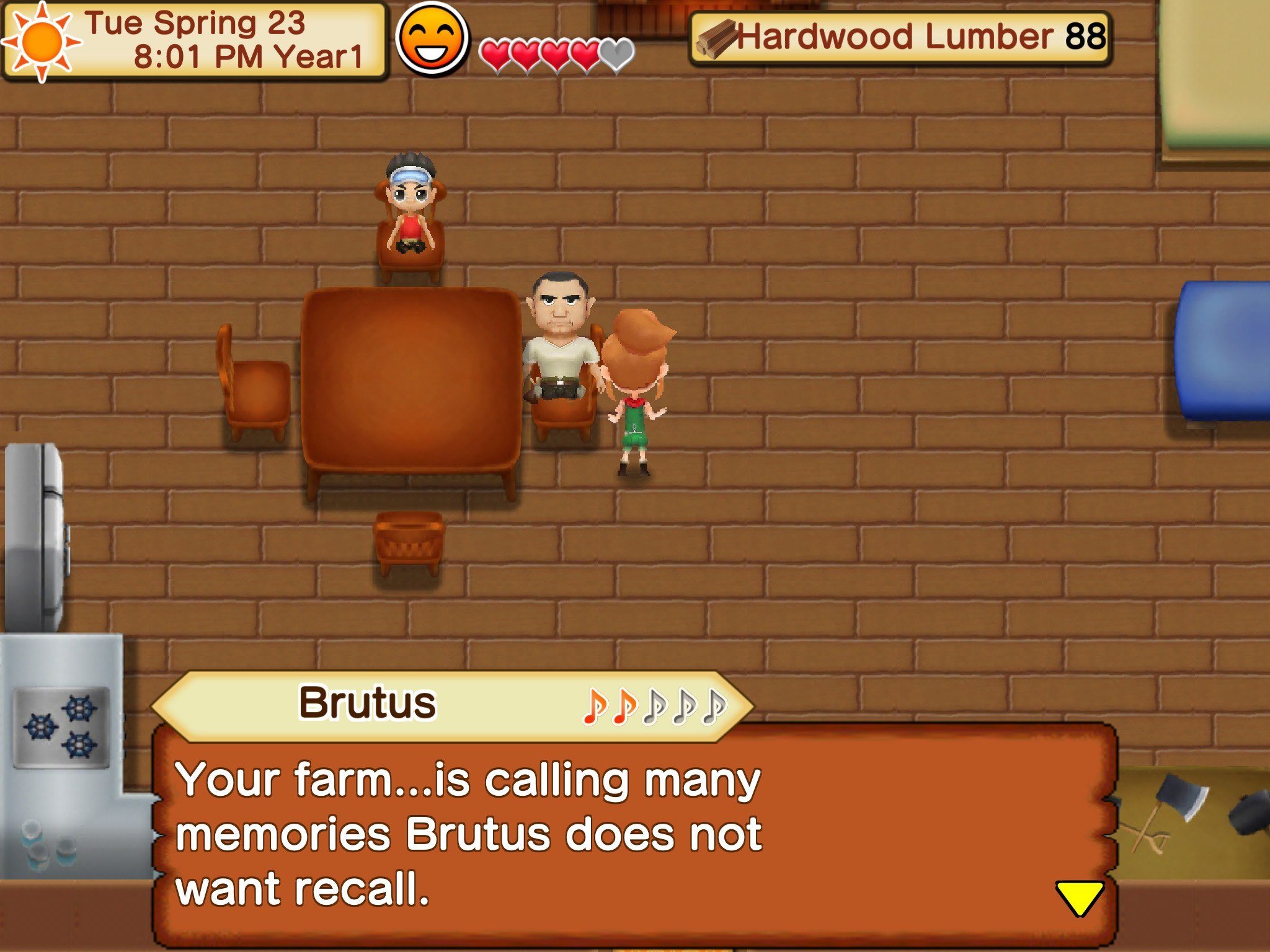
Seeds of Memories is as open-ended as any of the early Harvest Moons, but the memories system provides a helpful list of achievements to focus on. All 150 memories in the game are listed in the menu along with a hint to their completion. Most of them revolve around building relationships with villagers, e.g. “Become better friends with Gilbert,” or natural farming goals, such as “Ship 500 crops,” but it’s nice to have a checklist to return to if you’re feeling aimless. The other benefit of the memories system is that every memory, once completed, awards some sort of gift. These range from bags of seeds to expensive gems to unique, quest-only items, and it makes all of your efforts feel even more fruitful than they already would.
Another of my favorite aspects of this entry is its focus on progressing at your own pace. Many of the recent Harvest Moons forced unnecessary limitations on what you could or couldn’t do at a certain time: you couldn’t raise this type of animal until year three, you couldn’t build a bridge until summer, you couldn’t get married until year two, etc. These were artificial restrictions to lengthen an already endless game, and they don’t appear to exist in Seeds of Memories. Most of your progress is related to your own efforts: if you save up enough money and ore, you can upgrade all of your tools within a week. If you make friends fast enough, you can expand your farm within the first season. It’s possible I just haven’t come across the limiting factors yet, but even if they do show up, their presence is not a burden in the early game.
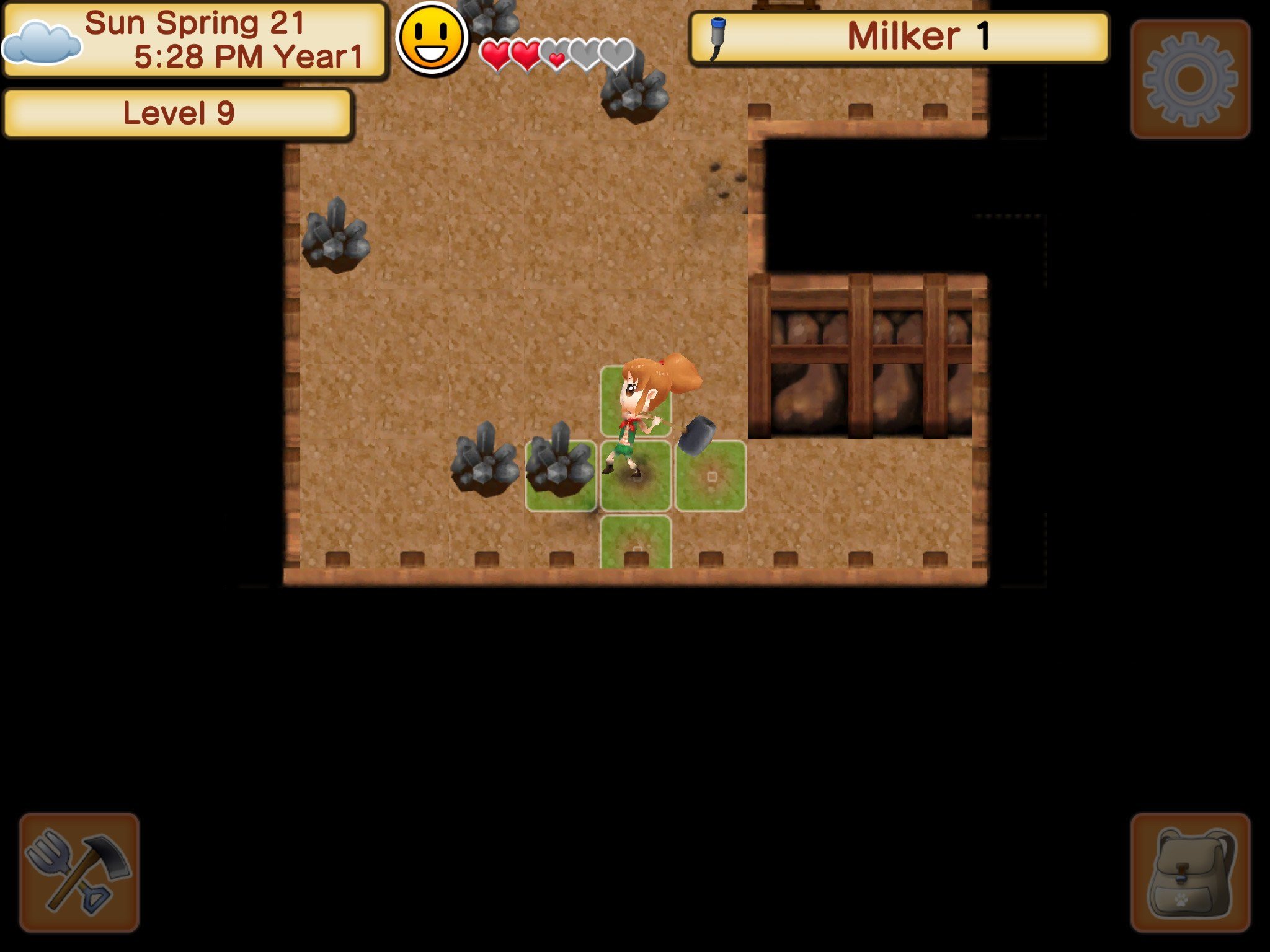
And it’s easy to push your farmer to his or her limits thanks to the excellently-implemented touch controls. Almost everything in the game is contextual, meaning you won’t have to constantly swap equipment to complete your daily chores. There are simply two modes: talk and farm modes, alternated by a button on the bottom-left of the screen. In farm mode, tapping an untilled plot of land will till it, tapping the prepared soil will open up the seed menu, and tapping multiple plots with seeds selected will sow them in a row. Once your tools are upgraded, you can drag along multiple squares of land to till/water/smash them at the same time, with a highlighted grid available to make visualizing what you’re doing a breeze. You can also alternate between tapping on a location to have your farmer run there automatically, or dragging your finger as a guide they will follow directly. Both have their uses, making it easy to cross large sections of the map or navigate smaller areas with ease.
This covers two of the Harvest Moon tenets—freedom and farming—but what about relationships? They’re a bit of a mixed bag. To start, the villagers (carried over from The Lost Valley) are fairly uninteresting. Besides their bizarre bout of collective amnesia, they mostly comment on the pretty flowers of spring or that you look tired. The fact that half of them have annoying, over-the-top dialects doesn’t help.
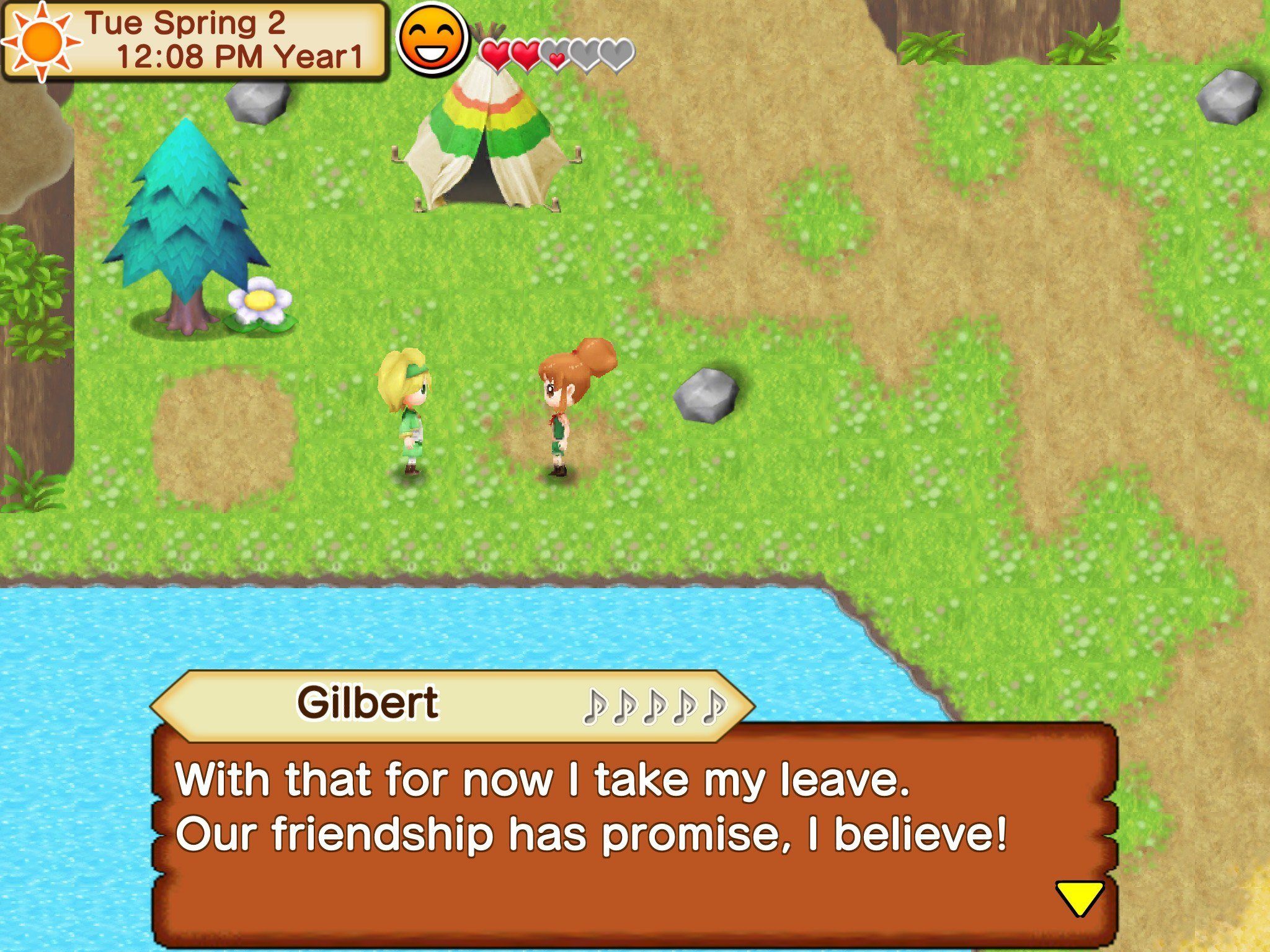
However, once you start building up friendships via gifts and unlocking events with them, their personalities are more vivacious than initially indicated. The rhyming bard, Gilbert, opens up about the lonely life of a traveling minstrel. The snippy waitress, Catherine, attempts to understand friendship. Some characters don’t like the life they’ve chosen, while others are perfectly content—discovering which is which is surprisingly engaging. The villager encyclopedia, which tracks birthdays, likes, and dislikes—all of which you must discover yourself—makes it easy to return to the game after a break without having to keep a friendship cheat sheet handy. And as relationships grow, so does your world: characters you are friends (or more) with may discover new areas or stock new items that were previously unavailable. There’s a tangible benefit to making friends in addition to the simple joy of getting to know someone.
All together, Harvest Moon: Seeds of Memories succeeds more than it stumbles. Its poor aesthetics and lack of world-building prior to your arrival are disappointing, but its gameplay and focus on the core components from the classic entries provide plenty of incentive to keep playing. While it’s far from the best Harvest Moon game, it’s a promising start for the series on a new platform, and hopefully a jumping-off point to a 20-year run on mobile.

The good
- All the classic Harvest Moon activities we know and love, including ranching, farming, mining, cooking, dating, and so on, are here in their full glory.
- Contextual touch controls makes doing any of the above quick and easy.
- Open-ended progress means you can exhaust yourself to riches or take a laid-back approach, expanding at your own pace.
- Huge rucksack lets you hoard to your heart's content.

The bad
- Visually bland and lacking in detail; easy to get tired of the same three, boring areas quickly.
- Characters have almost no interaction with each other or the world; they're simply marionettes that come to life at your touch.
- Economy is too mining-friendly; if you don't like mining, you're going to be poor for quite some time.
- "Youse/y'alls" dialects do not grow on you.
More articles...
Monopoly GO! Free Rolls – Links For Free Dice
By Glen Fox
Wondering how to get Monopoly GO! free rolls? Well, you’ve come to the right place. In this guide, we provide you with a bunch of tips and tricks to get some free rolls for the hit new mobile game. We’ll …Best Roblox Horror Games to Play Right Now – Updated Weekly
By Adele Wilson
Our Best Roblox Horror Games guide features the scariest and most creative experiences to play right now on the platform!The BEST Roblox Games of The Week – Games You Need To Play!
By Sho Roberts
Our feature shares our pick for the Best Roblox Games of the week! With our feature, we guarantee you'll find something new to play!Anime Fantasy Codes – Free Gems and Tokens
By Adele Wilson
Our Anime Fantasy Codes guide has a list of codes that offer up a variety of rewards, such as gems, tokens, and lots more!



